Upstream and Downstream Changes in the Channel Width and Sinuosity Due to Dam Construction in Tropical Rivers: The Case of Colombia
Abstract
1. Introduction
2. Materials and Methods
2.1. Study Sites
2.2. Data
2.2.1. Average Monthly Precipitation Data within the Basins
2.2.2. Discharge and Sediment Data
2.2.3. Remote Sensing Data
2.3. Morphological Parameter Estimation
2.4. Geological Information
3. Geological Context of Each Study Site
3.1. The Urrá I Project
3.2. The Salvajina Project
3.3. The Betania and Prado Projects
4. Results
4.1. Hydrology
4.1.1. Hydrological Regime
4.1.2. Annual Discharges
4.2. Erodibility Index
4.3. Morphological Changes
4.3.1. Downstream Morphological Changes
- Morphological changes downstream of the Urrá I Dam
- Morphological changes downstream of the Salvajina Dam
- Morphological changes downstream of the Betania and Prado Dams
- -
- Between 14–18 km, there is an erodible volcanic lithology (EI = 1.5) on a high-confinement area. Then, an increase in the channel width was observed in the post-dam period.
- -
- From 18 to 25 km, the channel width was reduced by about −62% between pre- and post-dam periods. This is a Magdalena River transition area from high- to low-confinement. The transition area is close to where the Frío River flows into the Magdalena River.
4.3.2. Upstream Morphological Changes
5. Discussion
5.1. Downstream Dam Effects
5.2. Upstream Dam Effects
5.3. Limitations
6. Conclusions
Author Contributions
Funding
Institutional Review Board Statement
Informed Consent Statement
Data Availability Statement
Acknowledgments
Conflicts of Interest
Appendix A
- Urrá I dam area:
- Q-al: Alluvial deposits and floodplains
- Q-ca: Alluvial fans and colluvial deposits
- n6n7-Sm: Intercalations of mudstones, calcareous arenites, and coarse-grained–conglomeratic quartz sandstone
- n6n7-St: Conglomerate intercalations, medium–conglomerate lithic–sublithic arenites, calcareous arenites, and mudstones
- n3n5-Sm: Fine–coarse-grained lithic and feldspathic sandstones with glauconite and calcareous shale intercalation with mudstones
- n1n2-St: Medium-grained lithic–sublithic sandstones interstratified with mudstones, locally peat, charcoal, and sandy conglomerate lenses
- e8n2-Sm: Limestone, sandstone, and calcareous mudstone
- e8n2-St: Ferruginous fine-grained–conglomeratic sandstone intercalation with calcareous siltstone and coal
- e3e4-Sm: Grain-decreasing lithic sandstones to conglomeratic–fine-grained sandstone intercalation with mudstones and micritic limestones
- k2k6-Sm7: Claystones, muddy and lithic sandstones, cherts, limestone, tuffs and agglomerates, local cataclassites
- Salvajina dam area:
- Q-al: Alluvial deposits and floodplains
- Q-ca: Alluvial fans and colluvial deposits
- Q-t: Alluvial terraces
- Q-Vc: Volcanoclastic flows made up of pyroclasts and epiclasts of andesitic composition
- N2-P: Ash tuffs and lapilli intercalation with lavas of andesitic composition
- N2-Vi: Lavas and ignimbrites of andesitic composition
- n1n2-Pi: Quartzodiorites, tonalites, diorites, and granodiorites
- N1-St: Claystones, siltstones, sandstones, and conglomerates
- e6e7-Stm: Conglomerates, lithic muddy sandstones, quartz sandstones, siltstones, claystones, and coals
- E3-St: Fine-grained quartz sandstones to conglomerate intercalation with conglomerates, mudstones, and coals
- k2-Vm7: Tholeiitic basalts, dolerites, picrites, basics tuff, and volcanic breccias
- k2k6-Sm7: Claystones, muddy and lithic sandstones, cherts, limestone, tuffs and agglomerates, local cataclassites
- K1-Mbg6: Amphibolite schists and quartzites
- Betania and Prado projects:
- Q-al: Alluvial deposits and floodplains
- Q-ca: Alluvial fans and colluvial deposits
- Q-t: Alluvial terraces
- Q2-Vc: Volcanoclastic flows constituted of pyroclasts and epiclasts of andesitic and dacitic composition
- N2Q1-VCc: Felspathic sandstones, claystones, and conglomerates rich in lithics of andesites and dacites
- n4n6-Sc: Lithic sandstones with intercalation of gray–green claystones and conglomerates
- e6e9-Sc: Intercalations of red beds of conglomerates, lithic conglomeratic sandstones, and claystones
- k6E1-Stm: Red claystones with intercalations of fine quartz sandstones, coal beds in the basin
- b6k6-Stm: Intercalations of shales, limestones, sandstones, cherts, and phosphorites
- b5b6-Sctm: Red conglomerates, feldesphatic sandstones and claystones, quartz sandstones, limestones and shales; in the top, ferruginous quartz and glauconites sandstones
- J-Pi: Monzogranite from Algeciras and Stock of Ibagué
- J-VCc: Tuffs, agglomerates, and lavas, occasionally intercalations of red beds of lithic sandstones and siltstones
- 1.0—acid plutonic rocks, metamorphic rocks, and carbonate sedimentary rocks
- 1.1—acid volcanic rocks
- 1.2—mixed sedimentary rocks
- 1.4—basic volcanic rocks; siliciclastic rocks of fine–medium grain sizes
- 1.5—basic plutonic rocks, siliciclastic rocks of high variability in grain sizes
- 3.2—unconsolidated sediments
Appendix B
| Project | Aerial Photographs | Satellite Images | |||
|---|---|---|---|---|---|
| Flight | Date | Name | Mission | Date | |
| Betania | C1431 | 12 September 1971 | |||
| C1866 | 1 March 1973 | LT05_L1TP_008058_19850322 | Landsat 5 | 22 March 1985 | |
| C1343 | 9 December 1970 | LT04_L1TP_008058_19880322 | Landsat 4 | 22 March 1988 | |
| C1518 | 11 September 1974 | LT05_L1TP_008058_19981004 | Landsat 5 | 4 October 1998 | |
| C1564 | 5 March 1975 | LC08_L1TP_008058_20151019 | Landsat 8 | 19 October 2015 | |
| C1256 | 22 March 1969 | LC08_L1TP_008058_20200322 | Landsat 8 | 22 March 2020 | |
| C1470 | 17 November 1973 | ||||
| Prado | C1256 | 22 March 1969 | LT05_L1TP_008057_19850322 | Landsat 5 | 22 March 1985 |
| M1393 | 24 February 1966 | LT04_L1TP_008057_19880322 | Landsat 4 | 22 March 1988 | |
| M152 | 29 March 1957 | LT05_L1TP_008057_19981004 | Landsat 5 | 4 October 1988 | |
| M153 | 30 March 1957 | LC08_L71TP_008057_20151019 | Landsat 8 | 19 October 2015 | |
| LC08_L1TP_008057_20200322 | Landsat 8 | 22 March 2020 | |||
| Urrá I | No flights | LT05_L1TP_010054_19910321 | Landsat 5 | 21 March 1991 | |
| LT05_L1TP_010054_19980103 | Landsat 5 | 3 January 1998 | |||
| AST_L1T_00301132007153521 | Aster | 13 January 2007 | |||
| LC08_L1TP_010054_20181228 | Landsat 8 | 28 December 2018 | |||
| S1B_IW_GRDH_1SDV_20200 | Sentinel 1B | 11 January 2020 | |||
| 111T104920 | |||||
| Salvajina | C1421 | 16 March 1972 | LT05_L1TP_009057_19840902 | Landsat 5 | 2 September 1984 |
| C1518 | 11 September 1974 | LT04_L1TP_009058_19880516 | Landsat 4 | 16 May 1988 | |
| M1098 | 14 August 1961 | AST_L1T_00301292007153659 | Aster | 29 January 2007 | |
| M1467 | 14 August 1961 | LC08_L1TP_009058_20190818 | Landsat 8 | 18 August 2019 | |
Appendix C
| ID | TEST | January | February | March | April | May | June | July | August | September | October | November | December |
|---|---|---|---|---|---|---|---|---|---|---|---|---|---|
| b1 | T | 0.01 | 0.00 | 0.00 | 0.13 | 0.57 | 0.66 | 0.91 | 0.57 | 0.90 | 0.63 | 0.90 | 0.25 |
| F | 0.91 | 0.74 | 0.74 | 0.89 | 0.39 | 0.02 | 0.39 | 0.02 | 0.34 | 0.37 | 0.02 | 0.31 | |
| b2 | T | 0.01 | 0.01 | 0.00 | 0.15 | 0.55 | 0.67 | 0.68 | 0.84 | 0.61 | 0.69 | 0.91 | 0.21 |
| F | 0.92 | 0.66 | 0.77 | 0.96 | 0.44 | 0.02 | 0.03 | 0.23 | 0.09 | 0.35 | 0.00 | 0.26 | |
| b3 | T | 0.10 | 0.06 | 0.02 | 0.09 | 0.53 | 0.87 | 0.36 | 0.81 | 0.68 | 0.48 | 0.04 | 0.68 |
| F | 0.72 | 0.64 | 0.41 | 0.81 | 0.98 | 0.63 | 0.54 | 0.18 | 0.53 | 0.00 | 0.82 | 0.46 | |
| b4 | T | 0.53 | 0.00 | 0.00 | 0.01 | 0.76 | 0.70 | 0.12 | 0.25 | 0.11 | 0.00 | 0.00 | 0.49 |
| F | 0.04 | 0.39 | 0.15 | 0.43 | 0.97 | 0.69 | 0.32 | 0.37 | 0.28 | 0.00 | 0.28 | 0.18 | |
| b5 | T | 0.63 | 0.04 | 0.00 | 0.00 | 0.49 | 0.62 | 0.87 | 0.62 | 0.82 | 0.06 | 0.04 | 0.59 |
| F | 0.56 | 0.01 | 0.76 | 0.02 | 0.47 | 0.97 | 0.72 | 0.02 | 0.14 | 0.02 | 0.60 | 0.05 | |
| b6 | T | 0.00 | 0.02 | 0.00 | 0.01 | 0.25 | 0.02 | 0.24 | 0.36 | 0.30 | 0.90 | 0.93 | 0.17 |
| F | 0.95 | 0.42 | 0.20 | 0.98 | 0.53 | 0.03 | 0.13 | 0.47 | 0.44 | 0.19 | 0.70 | 0.43 | |
| c1 | T | 0.71 | 0.43 | 0.85 | 0.00 | 0.00 | 0.03 | 0.75 | 0.05 | 0.08 | 0.16 | 0.02 | 0.48 |
| F | 0.94 | 0.96 | 0.35 | 0.19 | 0.25 | 0.60 | 0.48 | 0.00 | 0.41 | 0.26 | 0.73 | 0.19 | |
| c2 | T | 0.47 | 0.23 | 0.75 | 0.19 | 0.02 | 0.13 | 0.35 | 0.00 | 0.01 | 0.98 | 0.42 | 0.63 |
| F | 0.31 | 0.36 | 0.67 | 0.74 | 0.34 | 0.69 | 0.23 | 0.02 | 0.45 | 0.92 | 0.51 | 0.03 | |
| c3 | T | 0.41 | 0.56 | 0.56 | 0.66 | 0.02 | 0.18 | 0.2 | 0.00 | 0.00 | 0.05 | 0.00 | 0.45 |
| F | 0.76 | 0.50 | 0.83 | 0.93 | 0.65 | 0.00 | 0.26 | 0.50 | 0.07 | 0.03 | 0.60 | 0.38 | |
| d1 | T | 0.25 | 0.29 | 0.15 | 0.82 | 0.96 | 0.65 | 0.27 | 0.50 | 0.51 | 0.02 | 0.07 | 0.44 |
| F | 0.89 | 0.81 | 0.42 | 0.25 | 0.07 | 0.76 | 0.02 | 0.59 | 0.37 | 0.08 | 0.14 | 0.01 | |
| d2 | T | 0.95 | 0.59 | 0.82 | 0.15 | 0.11 | 0.38 | 0.44 | 0.72 | 0.06 | 0.00 | 0.28 | 0.88 |
| F | 0.15 | 0.98 | 0.86 | 0.71 | 0.73 | 0.73 | 0.53 | 0.92 | 0.69 | 0.82 | 0.66 | 0.29 | |
| d3 | T | 0.07 | 0.12 | 0.01 | 0.66 | 0.80 | 0.30 | 0.70 | 0.61 | 0.78 | 0.04 | 0.24 | 0.08 |
| F | 0.90 | 0.91 | 0.32 | 0.20 | 0.47 | 0.34 | 0.08 | 0.72 | 0.55 | 0.18 | 0.42 | 0.06 | |
| d4 | T | 0.77 | 0.99 | 0.18 | 0.52 | 0.32 | 0.70 | 0.31 | 0.47 | 0.08 | 0.01 | 0.00 | 0.29 |
| F | 0.88 | 0.47 | 0.30 | 0.73 | 0.62 | 0.73 | 0.50 | 0.99 | 0.71 | 0.02 | 0.68 | 0.08 |
| BASIN | TEST | January | February | March | April | May | June | July | August | September | October | November | December |
|---|---|---|---|---|---|---|---|---|---|---|---|---|---|
| Betania | T | 0.33 | 0.96 | 0.80 | 0.64 | 0.58 | 0.69 | 0.01 | 0.53 | 0.44 | 0.35 | 0.73 | 0.05 |
| F | 0.74 | 0.15 | 0.39 | 0.68 | 0.10 | 0.25 | 0.27 | 0.07 | 0.78 | 0.49 | 0.07 | 0.82 | |
| Salvajina | T | 0.36 | 0.66 | 0.11 | 0.25 | 0.89 | 0.65 | 0.00 | 0.26 | 0.46 | 0.06 | 0.10 | 0.40 |
| F | 0.07 | 0.34 | 0.65 | 0.90 | 0.70 | 0.08 | 0.01 | 0.10 | 0.78 | 0.01 | 0.42 | 0.39 | |
| Urrá I | T | 0.95 | 0.11 | 0.48 | 0.88 | 0.30 | 0.48 | 0.15 | 0.54 | 0.00 | 0.78 | 0.22 | 0.61 |
| F | 0.42 | 0.29 | 0.49 | 0.02 | 0.80 | 0.97 | 0.93 | 0.51 | 0.46 | 0.27 | 0.50 | 0.43 |
| Project | Station | Annual Value | Average Discharge (m³/s) | KS p-Value | MW p-Value | |
|---|---|---|---|---|---|---|
| Pre-Dam | Post-Dam | |||||
| Urrá I | El Toro | Min | 71 | 81 | 0.06 | 0.16 |
| Med | 348 | 328 | 0.96 | 0.48 | ||
| Max | 953 | 759 | 0.06 | 0.04 | ||
| Carrizola | Min | 79 | 117 | 0.49 | 0.24 | |
| Med | 329 | 353 | 0.70 | 0.92 | ||
| Max | 846 | 803 | 0.88 | 0.72 | ||
| Nueva Colombia | Min | 74 | 89 | 0.01 | 0.05 | |
| Med | 347 | 354 | 0.91 | 0.98 | ||
| Max | 820 | 802 | 0.44 | 0.70 | ||
| Montería | Min | 69 | 97 | 0.01 | 0.02 | |
| Med | 376 | 357 | 0.90 | 0.57 | ||
| Max | 876 | 781 | 0.01 | 0.01 | ||
| Sabana Nueva | Min | 78 | 92 | 0.04 | 0.22 | |
| Med | 352 | 348 | 0.80 | 0.87 | ||
| Max | 714 | 686 | 0.76 | 0.89 | ||
| Palma Central | Min | 72 | 113 | 0.00 | 0.01 | |
| Med | 352 | 412 | 0.07 | 0.05 | ||
| Max | 620 | 642 | 0.86 | 0.42 | ||
| Salvajina | La Balsa | Min | 67 | 66 | 0.798 | 0.592 |
| Med | 204 | 177 | 0.983 | 0.817 | ||
| Max | 542 | 424 | 0.144 | 0.023 | ||
| Tablanca | Min | 58 | 77 | 0.858 | 0.654 | |
| Med | 198 | 194 | 0.44 | 0.196 | ||
| Max | 576 | 447 | 0.277 | 0.793 | ||
| La Bolsa | Min | 68 | 105 | 0.008 | 0.02 | |
| Med | 233 | 232 | 0.458 | 0.313 | ||
| Max | 635 | 537 | 0.212 | 0.062 | ||
| Betania and Prado | Puente Santander | Min | 153 | 162 | 0.798 | 0.592 |
| Med | 488 | 487 | 0.983 | 0.817 | ||
| Max | 1796 | 1496 | 0.144 | 0.023 | ||
| Angostura | Min | 235 | 218 | 0.858 | 0.654 | |
| Med | 657 | 603 | 0.44 | 0.196 | ||
| Max | 2007 | 1829 | 0.277 | 0.793 | ||
| Purificación | Min | 216 | 273 | 0.008 | 0.02 | |
| Med | 744 | 790 | 0.458 | 0.313 | ||
| Max | 2591 | 2392 | 0.212 | 0.062 | ||
| Nariño | Min | 456 | 404 | 0.625 | 0.486 | |
| Med | 1153 | 1138 | 0.977 | 0.986 | ||
| Max | 3563 | 3147 | 0.279 | 0.093 | ||
Appendix D
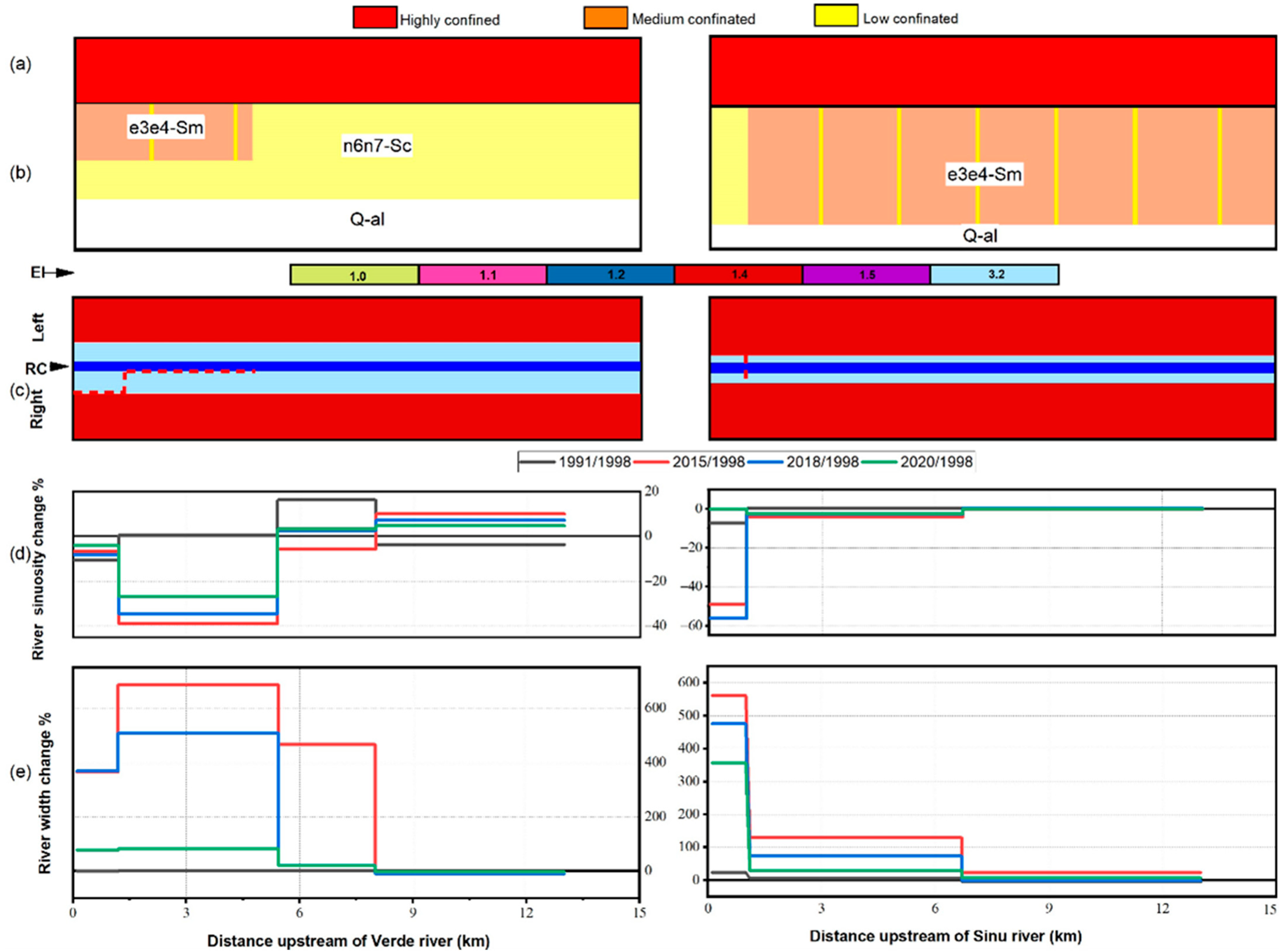
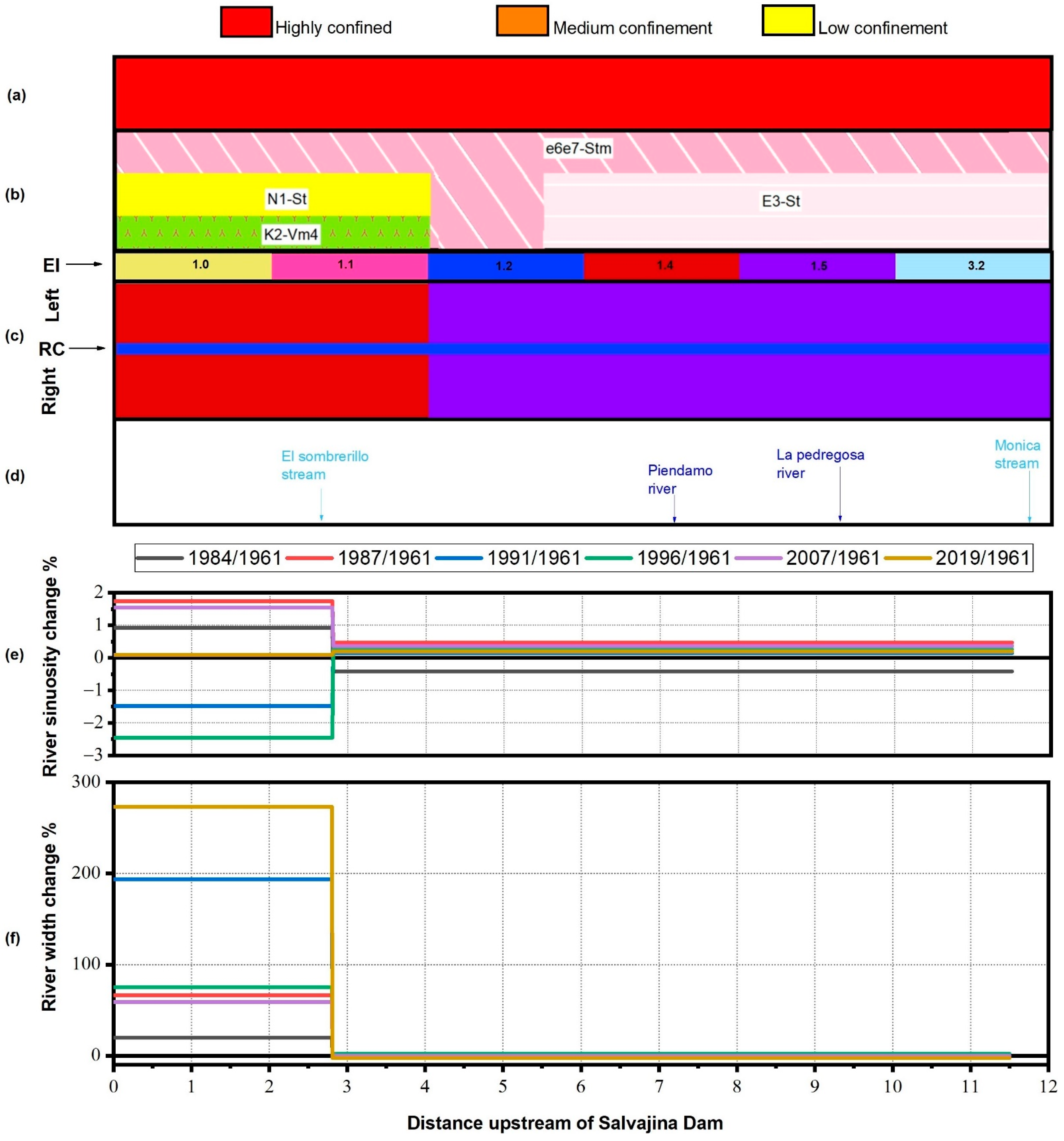
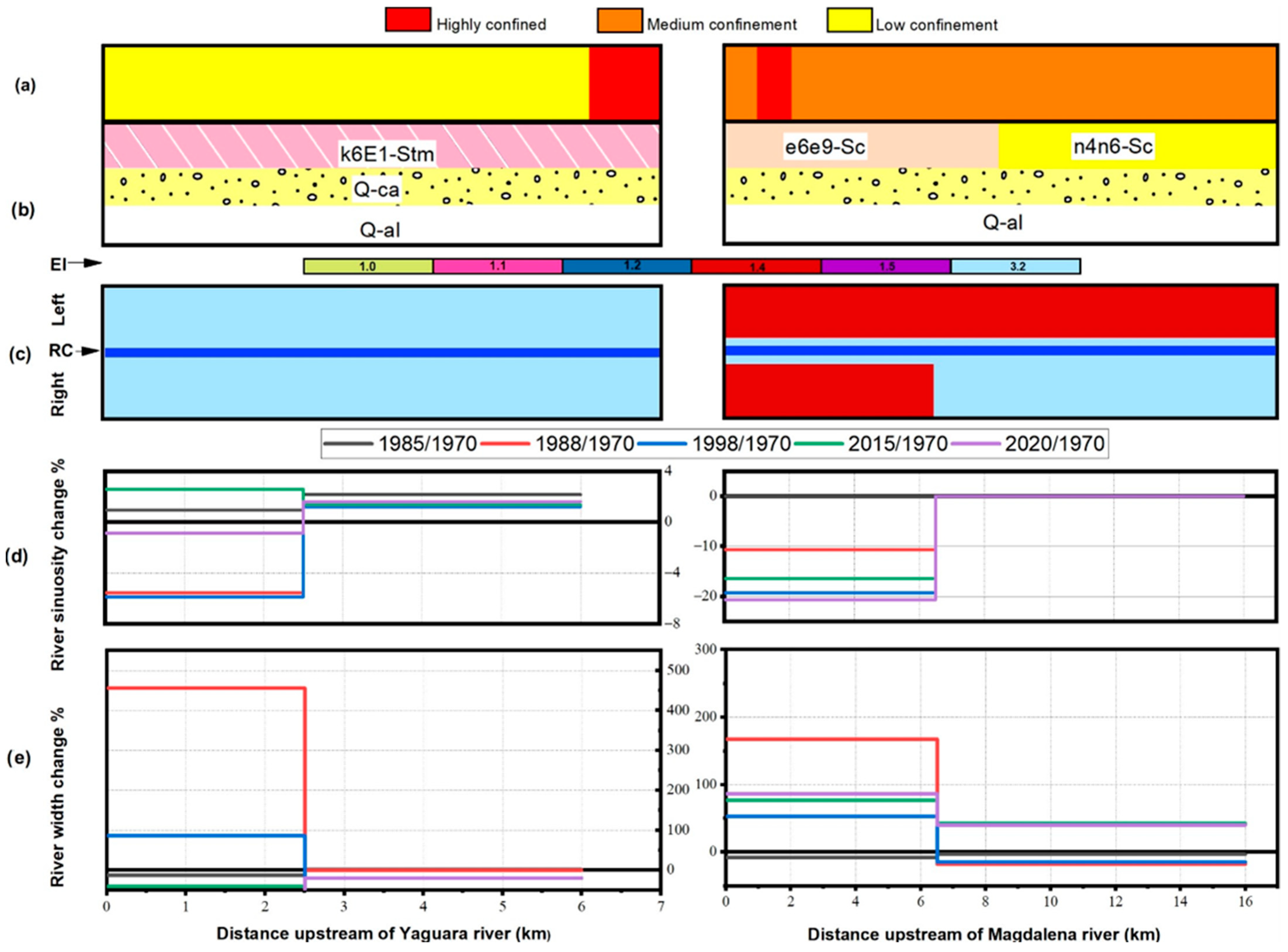
References
- Friedl, G.; Wüest, A. Disrupting Biogeochemical Cycles—Consequences of Damming. Aquat. Sci. 2002, 64, 55–65. [Google Scholar] [CrossRef]
- Csiki, S.; Rhoads, B.L. Hydraulic and Geomorphological Effects of Run-of-River Dams. Prog. Phys. Geogr. Earth Environ. 2010, 34, 755–780. [Google Scholar] [CrossRef]
- Gordon, E.; Meentemeyer, R.K. Effects of Dam Operation and Land Use on Stream Channel Morphology and Riparian Vegetation. Geomorphology 2006, 82, 412–429. [Google Scholar] [CrossRef]
- Skalak, K.J.; Benthem, A.J.; Schenk, E.R.; Hupp, C.R.; Galloway, J.M.; Nustad, R.A.; Wiche, G.J. Large Dams and Alluvial Rivers in the Anthropocene: The Impacts of the Garrison and Oahe Dams on the Upper Missouri River. Anthropocene 2013, 2, 51–64. [Google Scholar] [CrossRef]
- Baena-Escudero, R.; Guerrero-Amador, I.C.; Rinaldi, M.; González-Sayago, A. Hydrological and Geomorphic Effects Upstream of the Cantillana Dam along the Guadalquivir River (Southern Spain). Geomorphology 2021, 388, 107786. [Google Scholar] [CrossRef]
- Liro, M. Development of Sediment Slug Upstream from the Czorsztyn Reservoir (Southern Poland) and Its Interaction with River Morphology. Geomorphology 2016, 253, 225–238. [Google Scholar] [CrossRef]
- Brandt, S.A. Classification of Geomorphological Effects Downstream of Dams. CATENA 2000, 40, 375–401. [Google Scholar] [CrossRef]
- Williams, G.P.; Wolman, M.G. Downstream Effects of Dams on Alluvial Rivers; United States Geological Survey (USGS): Washington, DC, USA, 1984; pp. 1–94.
- Liu, X.; Wu, R.; Chen, X.; Zhou, Y.; Yang, L.; Ouyang, S.; Wu, X. Effects of Dams and Their Environmental Impacts on the Genetic Diversity and Connectivity of Freshwater Mussel Populations in Poyang Lake Basin, China. Freshw. Biol. 2020, 65, 264–277. [Google Scholar] [CrossRef]
- Stanley, E.H. Chapter 15—Understanding Ecosystem Effects of Dams. In Fundamentals of Ecosystem Science, 2nd ed.; Weathers, K.C., Strayer, D.L., Likens, G.E., Eds.; Academic Press: Cambridge, MA, USA, 2021; pp. 287–291. ISBN 978-0-12-812762-9. [Google Scholar]
- Evans, J.E.; Huxley, J.M.; Vincent, R.K. Upstream Channel Changes following Dam Construction and Removal Using a GIS/Remote Sensing Approach. J. Am. Water Resour. Assoc. 2007, 43, 683–697. [Google Scholar] [CrossRef]
- Liro, M. Conceptual Model for Assessing the Channel Changes Upstream Form Dam Reservoir. Quaest. Geogr. 2014, 33, 61–74. [Google Scholar] [CrossRef]
- Liro, M. Dam Reservoir Backwater as a Field-Scale Laboratory of Human-Induced Changes in River Biogeomorphology: A Review Focused on Gravel-Bed Rivers. Sci. Total Environ. 2019, 651, 2899–2912. [Google Scholar] [CrossRef] [PubMed]
- Maddock, T., Jr. Behaviour of Channels Upstream from Reservoirs. Int. Assoc. Sci. Hydrol. Publ. 1966, 71, 812–823. [Google Scholar]
- Petts, G.E. Long-Term Consequences of Upstream Impoundment. Environ. Conserv. 1980, 7, 325–332. [Google Scholar] [CrossRef]
- Lu, Y.; Zuo, L.; Ji, R.; Liu, H. Deposition and Erosion in the Fluctuating Backwater Reach of the Three Gorges Project after Upstream Reservoir Adjustment. Int. J. Sediment Res. 2010, 25, 64–80. [Google Scholar] [CrossRef]
- Grant, G.E. The Geomorphic Response of Gravel-Bed Rivers to Dams: Perspectives and Prospects. In Gravel-Bed Rivers; John Wiley & Sons, Ltd.: Hoboken, NJ, USA, 2012; pp. 165–181. ISBN 978-1-119-95249-7. [Google Scholar]
- Kondolf, G.M.; Gao, Y.; Annandale, G.W.; Morris, G.L.; Jiang, E.; Zhang, J.; Cao, Y.; Carling, P.; Fu, K.; Guo, Q.; et al. Sustainable Sediment Management in Reservoirs and Regulated Rivers: Experiences from Five Continents. Earths Future 2014, 2, 256–280. [Google Scholar] [CrossRef]
- Graf, W.L. Downstream Hydrologic and Geomorphic Effects of Large Dams on American Rivers. Geomorphology 2006, 79, 336–360. [Google Scholar] [CrossRef]
- Surian, N.; Cisotto, A. Channel Adjustments, Bedload Transport and Sediment Sources in a Gravel-Bed River, Brenta River, Italy. Earth Surf. Process. Landf. 2007, 32, 1641–1656. [Google Scholar] [CrossRef]
- Surian, N.; Rinaldi, M. Morphological Response to River Engineering and Management in Alluvial Channels in Italy. Geomorphology 2003, 50, 307–326. [Google Scholar] [CrossRef]
- Lu, X.X.; Siew, R.Y. Water Discharge and Sediment Flux Changes over the Past Decades in the Lower Mekong River: Possible Impacts of the Chinese Dams. Hydrol. Earth Syst. Sci. 2006, 10, 181–195. [Google Scholar] [CrossRef]
- Hadley, R.F.; Emmett, W.W. Channel Changes Downstream from a Dam. JAWRA J. Am. Water Resour. Assoc. 1998, 34, 629–637. [Google Scholar] [CrossRef]
- Yang, S.L.; Milliman, J.D.; Xu, K.H.; Deng, B.; Zhang, X.Y.; Luo, X.X. Downstream Sedimentary and Geomorphic Impacts of the Three Gorges Dam on the Yangtze River. Earth-Sci. Rev. 2014, 138, 469–486. [Google Scholar] [CrossRef]
- Rennie, C.D.; Church, M.; Venditti, J.G. Rock Control of River Geometry: The Fraser Canyons. J. Geophys. Res. Earth Surf. 2018, 123, 1860–1878. [Google Scholar] [CrossRef]
- Jain, V.; Fryirs, K.; Brierley, G. Where Do Floodplains Begin? The Role of Total Stream Power and Longitudinal Profile Form on Floodplain Initiation Processes. GSA Bull. 2008, 120, 127–141. [Google Scholar] [CrossRef]
- Słowik, M.; Dezső, J.; Marciniak, A.; Tóth, G.; Kovács, J. Evolution of River Planforms Downstream of Dams: Effect of Dam Construction or Earlier Human-Induced Changes? Earth Surf. Process. Landf. 2018, 43, 2045–2063. [Google Scholar] [CrossRef]
- Jiongxin, X. Channel Pattern Change Downstream from a Reservoir: An Example of Wandering Braided Rivers. Geomorphology 1996, 15, 147–158. [Google Scholar] [CrossRef]
- Chong, X.Y.; Vericat, D.; Batalla, R.J.; Teo, F.Y.; Lee, K.S.P.; Gibbins, C.N. A Review of the Impacts of Dams on the Hydromorphology of Tropical Rivers. Sci. Total Environ. 2021, 794, 148686. [Google Scholar] [CrossRef]
- Grant, G.E.; Schmidt, J.C.; Lewis, S.L. A Geological Framework for Interpreting Downstream Effects of Dams on Rivers. In A Peculiar River; American Geophysical Union (AGU): Washington, DC, USA, 2003; pp. 203–219. ISBN 978-1-118-66573-2. [Google Scholar]
- Smith, N.D.; Morozova, G.S.; Pérez-Arlucea, M.; Gibling, M.R. Dam-Induced and Natural Channel Changes in the Saskatchewan River below the E.B. Campbell Dam, Canada. Geomorphology 2016, 269, 186–202. [Google Scholar] [CrossRef]
- Takahashi, M.; Nakamura, F. Impacts of Dam-Regulated Flows on Channel Morphology and Riparian Vegetation: A Longitudinal Analysis of Satsunai River, Japan. Landsc. Ecol. Eng. 2011, 7, 65–77. [Google Scholar] [CrossRef]
- Cluett, L.J.; Radford, B.T.M. Downstream Morphological Change in Response to Dam Construction: A GIS Based Approach for the Lower Ord River, Western Australia. Water Sci. Technol. 2003, 48, 1–8. [Google Scholar] [CrossRef]
- Leopold, L.B.; Maddock, T., Jr. The Hydraulic Geometry of Stream Channels and Some Physiographic Implications; United States Geological Survey: Washington, DC, USA, 1953; pp. 1–57.
- Leopold, L.B.; Wolman, M.G. River Channel Patterns: Braided, Meandering, and Straight; United States Geological Survey: Washington, DC, USA, 1957; pp. 39–85.
- Booker, D.J. Predicting Wetted Width in Any River at Any Discharge. Earth Surf. Process. Landf. 2010, 35, 828–841. [Google Scholar] [CrossRef]
- Vargas-Luna, A.; Crosato, A.; Byishimo, P.; Uijttewaal, W.S.J. Impact of Flow Variability and Sediment Characteristics on Channel Width Evolution in Laboratory Streams. J. Hydraul. Res. 2019, 57, 51–61. [Google Scholar] [CrossRef]
- Gardner, T.A.; Von Hase, A.; Brownlie, S.; Ekstrom, J.M.M.; Pilgrim, J.D.; Savy, C.E.; Stephens, R.T.T.; Treweek, J.; Ussher, G.T.; Ward, G.; et al. Biodiversity Offsets and the Challenge of Achieving No Net Loss. Conserv. Biol. J. Soc. Conserv. Biol. 2013, 27, 1254–1264. [Google Scholar] [CrossRef] [PubMed]
- Harman, W.; Starr, R.; Carter, M.; Tweedy, K.; Clemmons, M.; Suggs, K.; Miller, C. A Function-Based Framework for Stream Assessment and Restoration Projects; United States Environmental Protection Agency (EPA), Office of Wetlands, Oceans and Watersheds: Washington, DC, USA, 2012; p. 344.
- Baez-Villanueva, O.M.; Zambrano-Bigiarini, M.; Ribbe, L.; Nauditt, A.; Giraldo-Osorio, J.D.; Thinh, N.X. Temporal and Spatial Evaluation of Satellite Rainfall Estimates over Different Regions in Latin-America. Atmos. Res. 2018, 213, 34–50. [Google Scholar] [CrossRef]
- Giraldo-Osorio, J.D.; Trujillo-Osorio, D.E.; Baez-Villanueva, O.M. Analysis of ENSO-Driven Variability, and Long-Term Changes, of Extreme Precipitation Indices in Colombia, Using the Satellite Rainfall Estimates CHIRPS. Water 2022, 14, 1733. [Google Scholar] [CrossRef]
- Restrepo, J.D.; Kettner, A.J.; Syvitski, J.P.M. Recent Deforestation Causes Rapid Increase in River Sediment Load in the Colombian Andes. Anthropocene 2015, 10, 13–28. [Google Scholar] [CrossRef]
- Restrepo, J.D.; Escobar, H.A. Sediment Load Trends in the Magdalena River Basin (1980–2010): Anthropogenic and Climate-Induced Causes. Geomorphology 2018, 302, 76–91. [Google Scholar] [CrossRef]
- Gutiérrez Rodríguez, H. Central Hidroeléctrica del río Prado: Nota Preliminar; Instituto de Aprovechamiento de Aguas y Fomento Eléctrico—Servicio Geológico Colombiano (SGC): Bogotá, Colombia, 1959; p. 15.
- ICEL. Propuesta para la Ejecución de la Central Hidroeléctrica de Betania; Instituto Colombiano de Energía Eléctrica (ICEL)—Ministerio de Minas y Energía: Bogotá, Colombia, 1978; p. 66.
- Mazuera González, Ó.E. Proyecto de Regulación del río Cauca; Corporacion Autonoma Regional del Valle del Cauca (CVC): Cali, Colombia, 1972; p. 219.
- Congreso de Colombia. Fundamentos de la Política Ambiental Colombiana; República de Colombia: Bogotá, Colombia, 1993; p. 47.
- Muñoz-Sabater, J. ERA5-Land Monthly Averaged Data from 1950 to Present. Copernicus Climate Change Service (C3S) Climate Data Store (CDS) 2019. Available online: https://cds.climate.copernicus.eu/cdsapp#!/dataset/reanalysis-era5-land-monthly-means (accessed on 15 May 2023).
- Zuo, Q.; Liang, S. Effects of Dams on River Flow Regime Based on IHA/RVA. Proc. IAHS 2015, 368, 275–280. [Google Scholar] [CrossRef]
- Šarauskienė, D.; Adžgauskas, G.; Kriaučiūnienė, J.; Jakimavičius, D. Analysis of Hydrologic Regime Changes Caused by Small Hydropower Plants in Lowland Rivers. Water 2021, 13, 1961. [Google Scholar] [CrossRef]
- Song, X.; Zhuang, Y.; Wang, X.; Li, E.; Zhang, Y.; Lu, X.; Yang, J.; Liu, X. Analysis of Hydrologic Regime Changes Caused by Dams in China. J. Hydrol. Eng. 2020, 25, 05020003. [Google Scholar] [CrossRef]
- Meitzen, K.M. Stream Flow Changes across North Carolina (USA) 1955–2012 with Implications for Environmental Flow Management. Geomorphology 2016, 252, 171–184. [Google Scholar] [CrossRef]
- Yaghmaei, H.; Sadeghi, S.H.; Moradi, H.; Gholamalifard, M. Effect of Dam Operation on Monthly and Annual Trends of Flow Discharge in the Qom Rood Watershed, Iran. J. Hydrol. 2018, 557, 254–264. [Google Scholar] [CrossRef]
- Dahmen, E.R.; Hall, M.J. Screening of Hydrological Data: Tests for Stationarity and Relative Consistency; ILRI Publication; International Institute for Land Reclamation and Improvement: Wageningen, The Netherlands, 1990; ISBN 978-90-70754-23-5. [Google Scholar]
- Mathias Kondolf, G.; Batalla, R.J. Chapter 11 Hydrological Effects of Dams and Water Diversions on Rivers of Mediterranean-Climate Regions: Examples from California. In Developments in Earth Surface Processes; Catchment Dynamics and River Processes; Garcia, C., Batalla, R.J., Eds.; Elsevier: Amsterdam, The Netherlands, 2005; Volume 7, pp. 197–211. [Google Scholar]
- Zhang, W.; Mu, S.; Zhang, Y.; Chen, K. Seasonal and Interannual Variations of Flow Discharge from Pearl River into Sea. Water Sci. Eng. 2012, 5, 399–409. [Google Scholar] [CrossRef]
- Ali, R.; Ismael, A.; Heryansyah, A.; Nawaz, N. Long Term Historic Changes in the Flow of Lesser Zab River, Iraq. Hydrology 2019, 6, 22. [Google Scholar] [CrossRef]
- Cunnane, C. Statistical Distributions for Flood Frequency Analysis; Operational Hydrology Report (OHR); Secretariat of the World Meteorological Organization: Geneva, Switzerland, 1989; ISBN 978-92-63-10718-3. [Google Scholar]
- Da Silva, R.M.; Santos, C.A.G.; Moreira, M.; Corte-Real, J.; Silva, V.C.L.; Medeiros, I.C. Rainfall and River Flow Trends Using Mann–Kendall and Sen’s Slope Estimator Statistical Tests in the Cobres River Basin. Nat. Hazards 2015, 77, 1205–1221. [Google Scholar] [CrossRef]
- Barajas Ibañez, H.; Leiva Fonseca, P.A. Evaluación del Cambio Morfológico y Sedimentológico del Cauce del Río Sinú Aguas Abajo de la presa del Embalse Urrá Asociados a su Construcción y Operación. Bachelor’s Thesis, Universidad de La Salle, Bogotá, Colombia, 2016. [Google Scholar]
- Arandia Suárez, A. Estimación de los Cambios Hidrológicos, Sedimentológicos y Morfológicos en ríos Aluviales Intervenidos por Presas de Gran Altura. Master’s Thesis, Universidad de Los Andes, Bogotá, Colombia, 2018. [Google Scholar]
- Laverde Mesa, L. Evaluación del Impacto de los Embalses por Retención de Sedimentos Sobre la Morfología del Cauce del Río Magdalena Mediante el Análisis de Tramos Representativos en el Comportamiento Sedimentológico Entre el Embalse de Betania y el Municipio de Regidor. Bachelor’s Thesis, Universidad de La Salle, Bogotá, Colombia, 2016. [Google Scholar]
- Ramírez Callejas, C.A.; Bocanegra Vinasco, R.A.; Sandoval García, M.C. La carga sedimentaria en el río Cauca en su alto valle geográfico. Ing. Recur. Nat. Ambiente 2009, 8, 68–82. [Google Scholar]
- CVC; Universidad del Valle. Caracterización del río Cauca y Tributarios: Tramo Salvajina—La Virginia; Universidad del Valle: Santiago de Cali, Colombia; Corporación Autónoma Regional del Valle del Cauca (CVC): Santiago de Cali, Colombia, 2001; p. 116. [Google Scholar]
- Donovan, M.; Belmont, P.; Notebaert, B.; Coombs, T.; Larson, P.; Souffront, M. Accounting for Uncertainty in Remotely-Sensed Measurements of River Planform Change. Earth-Sci. Rev. 2019, 193, 220–236. [Google Scholar] [CrossRef]
- Pogson, M.; Smith, P. Effect of Spatial Data Resolution on Uncertainty. Environ. Model. Softw. 2015, 63, 87–96. [Google Scholar] [CrossRef]
- Bruno, L.O. GRASS: A Free and Open Source Solution for Hydrographic Body Analysis. Nativa 2017, 5, 24–30. [Google Scholar] [CrossRef]
- Xu, H. Modification of Normalised Difference Water Index (NDWI) to Enhance Open Water Features in Remotely Sensed Imagery. Int. J. Remote Sens. 2006, 27, 3025–3033. [Google Scholar] [CrossRef]
- Filipponi, F. Sentinel-1 GRD Preprocessing Workflow. Proceedings 2019, 18, 11. [Google Scholar] [CrossRef]
- Zhang, W.; Hu, B.; Brown, G.S. Automatic Surface Water Mapping Using Polarimetric SAR Data for Long-Term Change Detection. Water 2020, 12, 872. [Google Scholar] [CrossRef]
- Golly, A.; Turowski, J.M. Deriving Principal Channel Metrics from Bank and Long-Profile Geometry with the R Package Cmgo. Earth Surf. Dyn. 2017, 5, 557–570. [Google Scholar] [CrossRef]
- Gómez Tapias, J.; Montes Ramírez, N.E.; Nivia Guevara, Á.; Diederix, H. Mapa Geológico de Colombia 2015. Available online: https://www2.sgc.gov.co/MGC/Paginas/mgc_1M2015.aspx (accessed on 10 May 2023).
- Zondervan, J.R.; Stokes, M.; Boulton, S.J.; Telfer, M.W.; Mather, A.E. Rock Strength and Structural Controls on Fluvial Erodibility: Implications for Drainage Divide Mobility in a Collisional Mountain Belt. Earth Planet. Sci. Lett. 2020, 538, 116221. [Google Scholar] [CrossRef]
- Sklar, L.S.; Dietrich, W.E. Sediment and Rock Strength Controls on River Incision into Bedrock. Geology 2001, 29, 1087–1090. [Google Scholar] [CrossRef]
- Moosdorf, N.; Cohen, S.; von Hagke, C. A Global Erodibility Index to Represent Sediment Production Potential of Different Rock Types. Appl. Geogr. 2018, 101, 36–44. [Google Scholar] [CrossRef]
- Fryirs, K.A.; Wheaton, J.M.; Brierley, G.J. An Approach for Measuring Confinement and Assessing the Influence of Valley Setting on River Forms and Processes. Earth Surf. Process. Landf. 2016, 41, 701–710. [Google Scholar] [CrossRef]
- Poveda, G.; Mesa, O.J. On the Existence of Lloró (the Rainiest Locality on Earth): Enhanced Ocean-Land-Atmosphere Interaction by a Low-Level Jet. Geophys. Res. Lett. 2000, 27, 1675–1678. [Google Scholar] [CrossRef]
- Quintero Camacho, W. Informe Preliminar de Áreas de Interés Regional para Encontrar Yacimientos de Hidrocarburos no Convencionales (Shale Gas), a Partir de Información Geofísica (Magnetometría y Gravimetría) en la Cuenca del Sinú—San Jacinto; Servicio Geológico Colombiano (SGC): Bogotá, Colombia, 2016; p. 18.
- Barbosa Camacho, G. Memoria Explicativa: Mapa Geológico del Departamento del Cauca; Instituto de Investigación e Información Geocientífica, Minero-Ambiental y Nuclear (INGEOMINAS)—Servicio Geológico Colombiano (SGC): Santiago de Cali, Colombia, 2003; p. 221.
- Núñez Tello, A.; Ferreira Vesga, P.; Rodríguez, M.Á. Levantamiento Geológico de la Plancha 323, Neiva, Huila; Instituto de Investigación e Información Geocientífica, Minero-Ambiental y Nuclear (INGEOMINAS)—Servicio Geológico Colombiano (SGC): Bogotá, Colombia, 2002; p. 94.
- Mojica, J.; Franco, R. Estructura y evolución tectónica del valle medio y superior del Magdalena, Colombia. Geol. Colomb. 1990, 17, 41–64. [Google Scholar]
- Villarroael, C.A.; Setoguchi, T.; Brieva, J.; Macía, C. Geology of the La Tatacoa “Desert” (Huila, Colombia): Precisions on the Stratigraphy of the Honda Group, the Evolution of the “Pata High” and the Presence of the La Venta Fauna. Mem. Fac. Sci. Kyoto Univ. Ser. Geol. Mineral. 1996, 58, 41–66. [Google Scholar]
- Armenta Porras, G.E. Análisis detallado del Efecto Foehn generado por la Cordillera Oriental en el Alto Magdalena (Huila y Tolima). Master’s Thesis, Universidad Nacional de Colombia, Bogotá, Colombia, 2013. [Google Scholar]
- Dill, H.G.; Andrei, B.; Sorin-Ionut, B.; Kristian, U.; Jorge, G.T.; Daniel, B.; Thomas, C. The “Badland Trilogy” of the Desierto de La Tatacoa, Upper Magdalena Valley, Colombia, a Result of Geodynamics and Climate: With a Review of Badland Landscapes. CATENA 2020, 194, 104696. [Google Scholar] [CrossRef]
- Kammer, A.; Piraquive Bermúdez, A. Evidencias sedimentológicas y estructurales para un origen paleógeno de la Falla de Chusma, Valle Superior del Magdalena, borde occidental de la sub-cuenca de Neiva. Geol. Colomb. 2013, 38, 43–64. [Google Scholar]
- Barjasteh, A. Influence of Geological Structure on Dam Behavior and Case Studies. In Dam Engineering; Mudanya Üniversitesi: Bursa, Turkey, 2019; p. 106. ISBN 978-1-78985-480-0. [Google Scholar]
- Nelson, N.C.; Erwin, S.O.; Schmidt, J.C. Spatial and Temporal Patterns in Channel Change on the Snake River Downstream from Jackson Lake Dam, Wyoming. Geomorphology 2013, 200, 132–142. [Google Scholar] [CrossRef]
- Adib, A.; Foladfar, H.; Roozy, A. Role of Construction of Large Dams on River Morphology (Case Study: The Karkheh Dam in Iran). Arab. J. Geosci. 2016, 9, 661. [Google Scholar] [CrossRef]
- O’Brien, G.R.; Wheaton, J.M.; Fryirs, K.; Macfarlane, W.W.; Brierley, G.; Whitehead, K.; Gilbert, J.; Volk, C. Mapping Valley Bottom Confinement at the Network Scale. Earth Surf. Process. Landf. 2019, 44, 1828–1845. [Google Scholar] [CrossRef]
- Csiki, S.J.; Rhoads, B.L. Influence of Four Run-of-River Dams on Channel Morphology and Sediment Characteristics in Illinois, USA. Geomorphology 2014, 206, 215–229. [Google Scholar] [CrossRef]
- Turowski, J.M. Alluvial Cover Controlling the Width, Slope and Sinuosity of Bedrock Channels. Earth Surf. Dyn. 2018, 6, 29–48. [Google Scholar] [CrossRef]
- Schumm, S.A.; Dumont, J.F.; Holbrook, J.M. Active Tectonics and Alluvial Rivers; Cambridge University Press: New York, NY, USA, 2002; ISBN 978-0-521-89058-8. [Google Scholar]
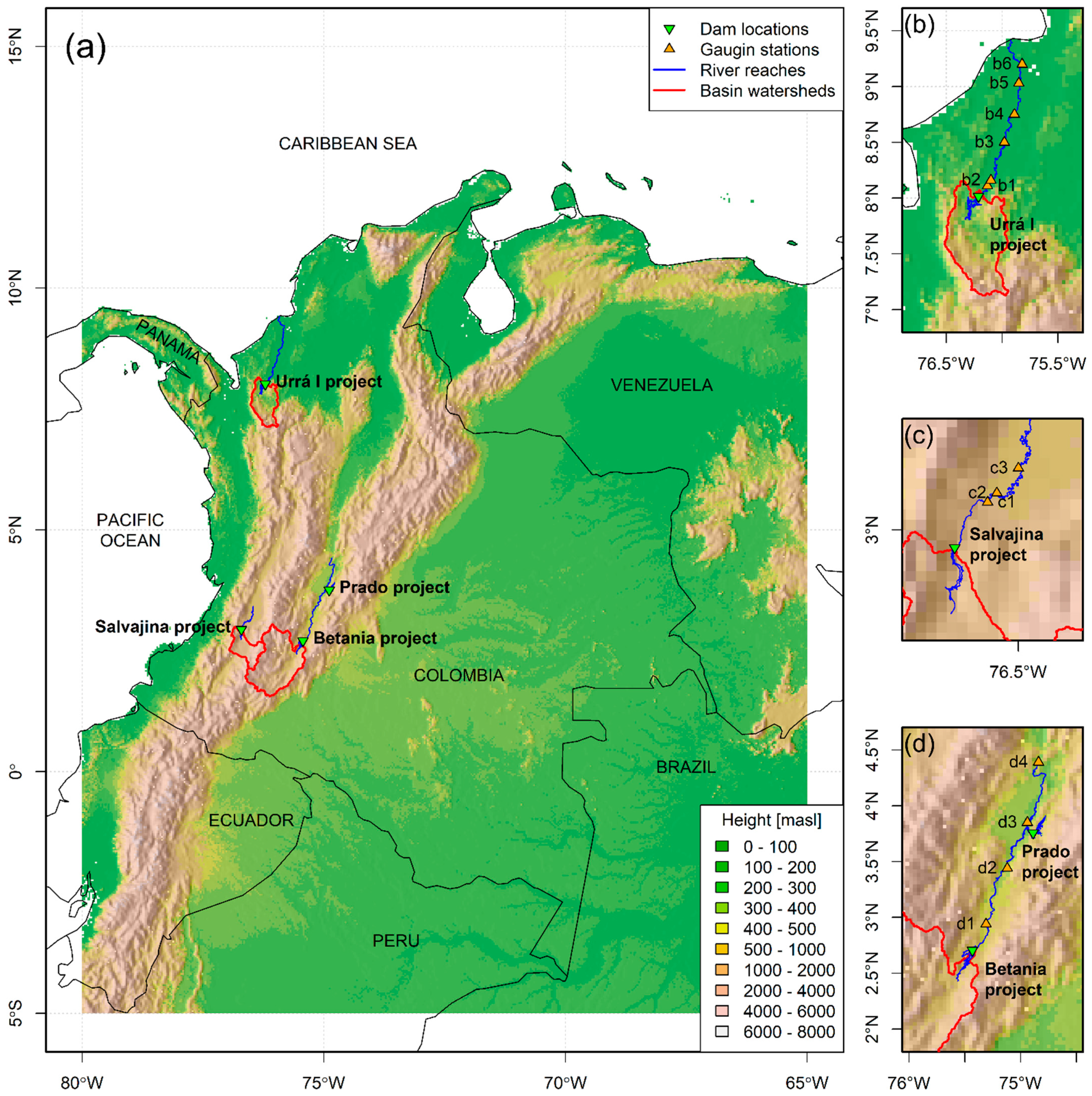
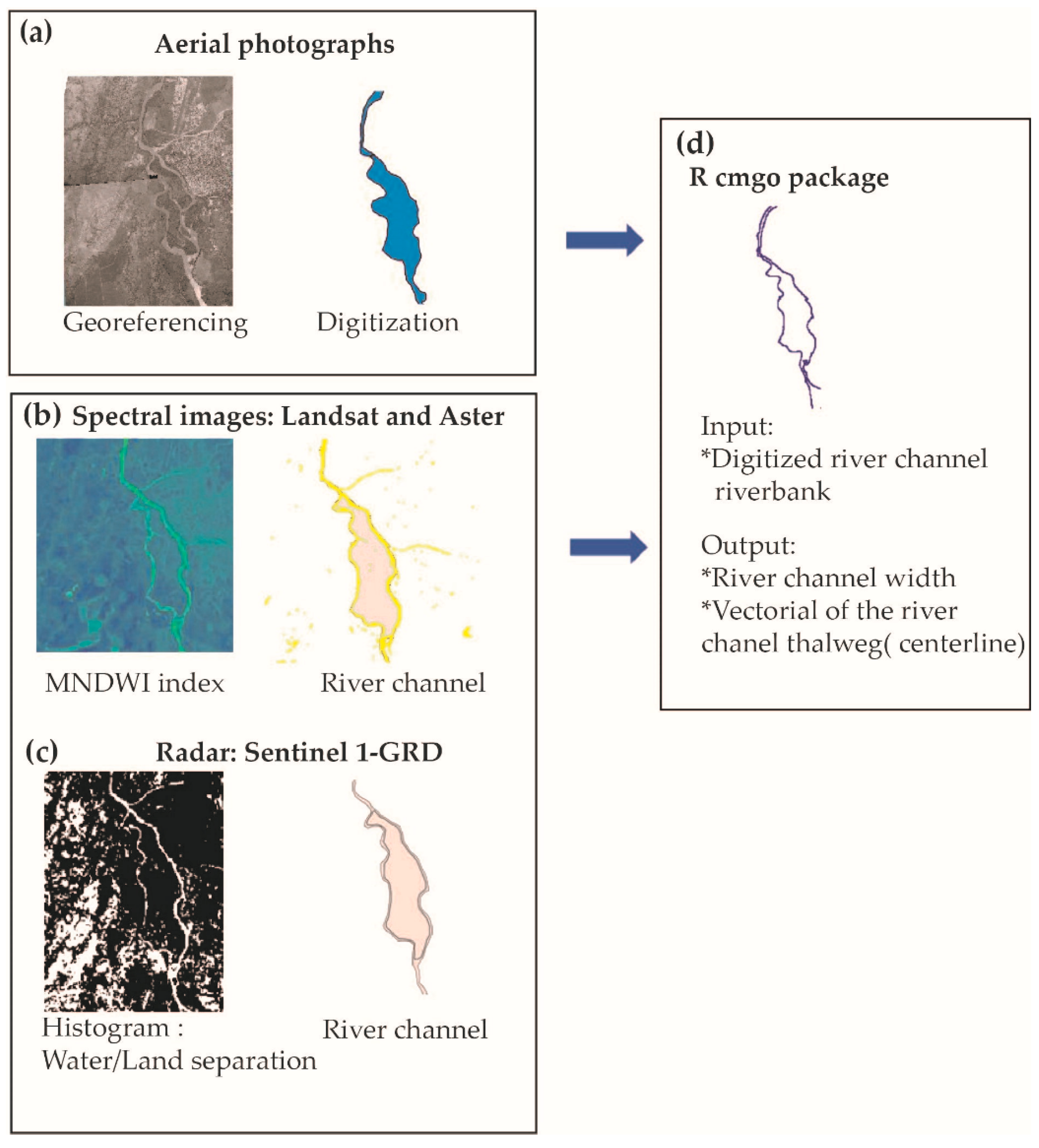
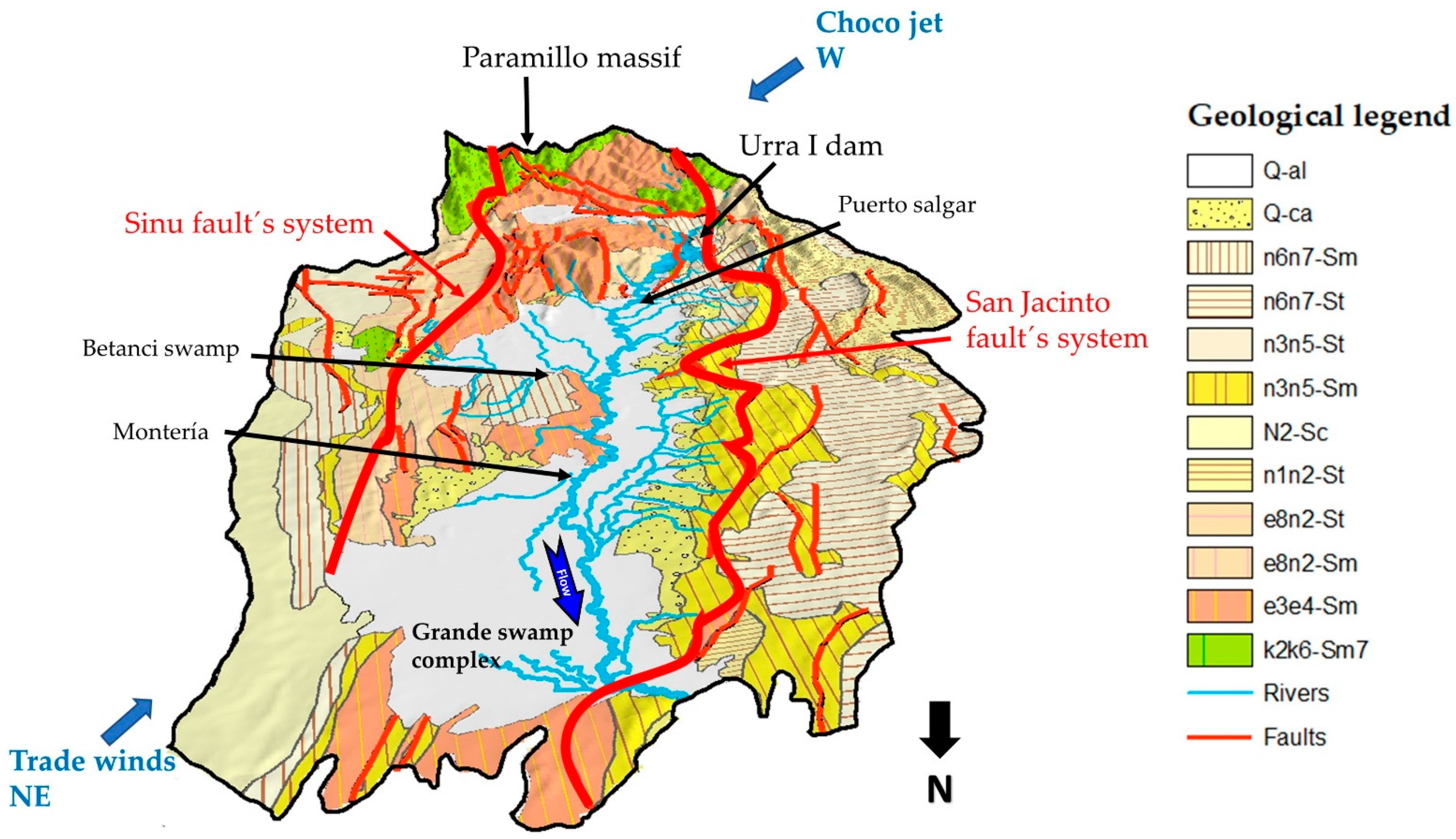
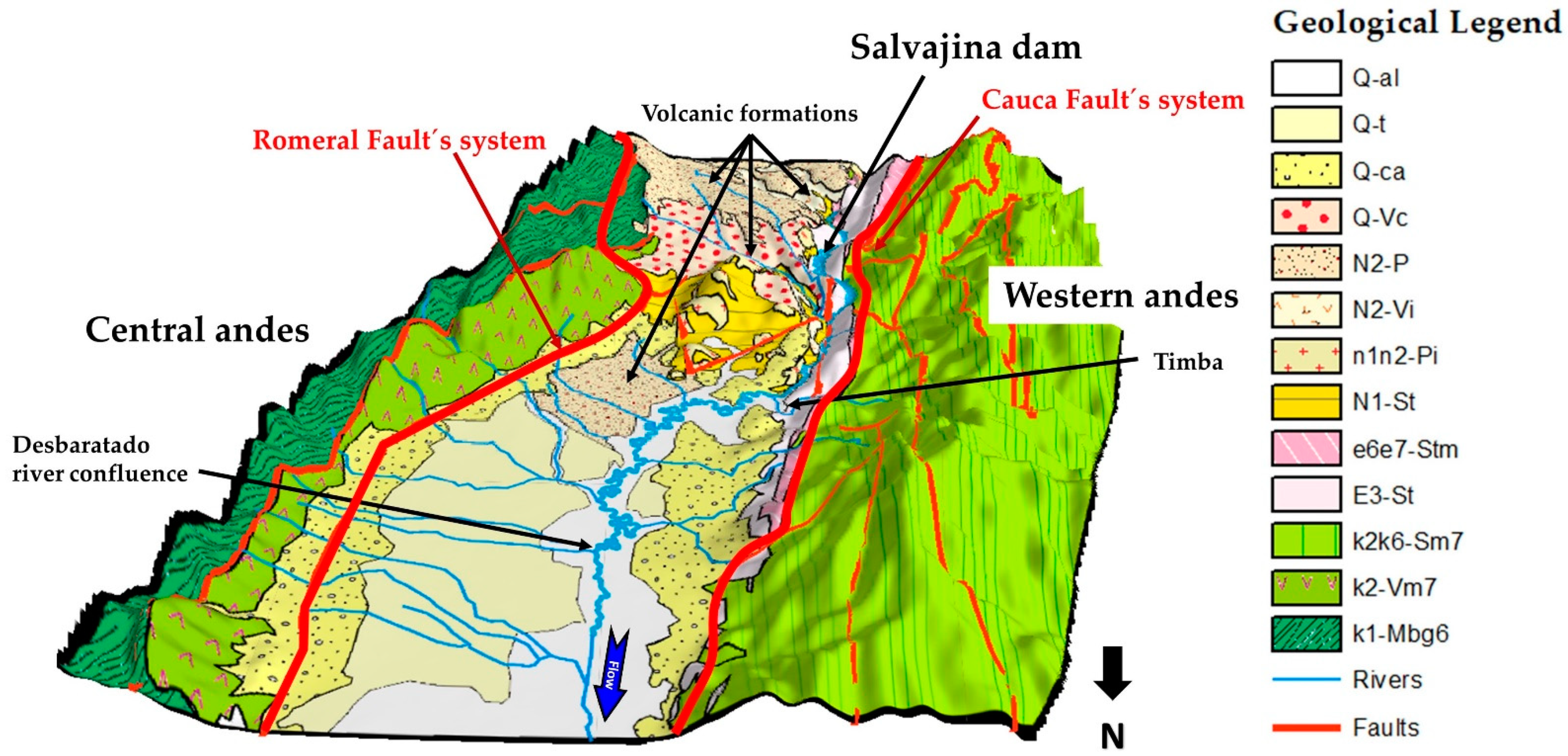
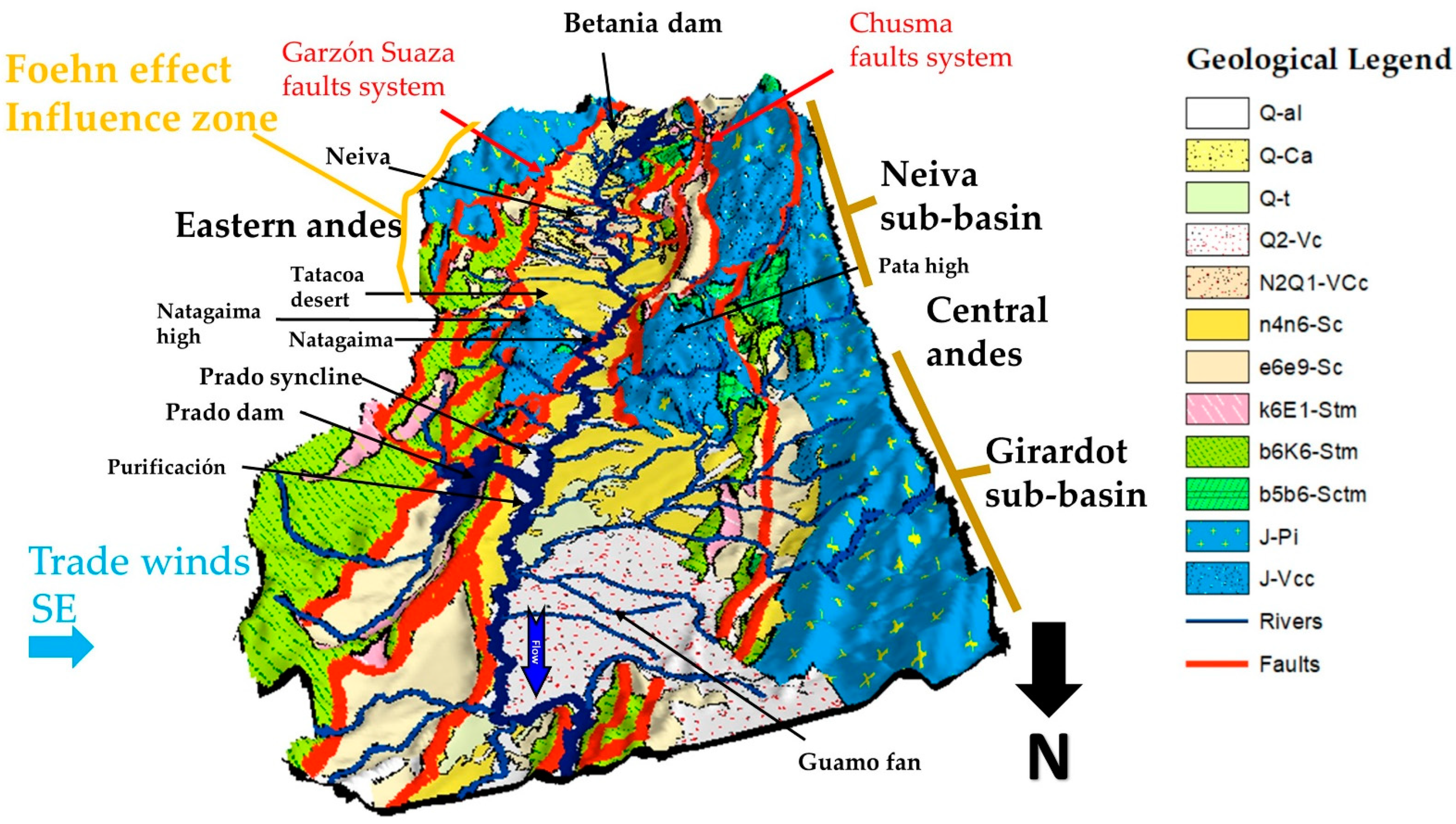
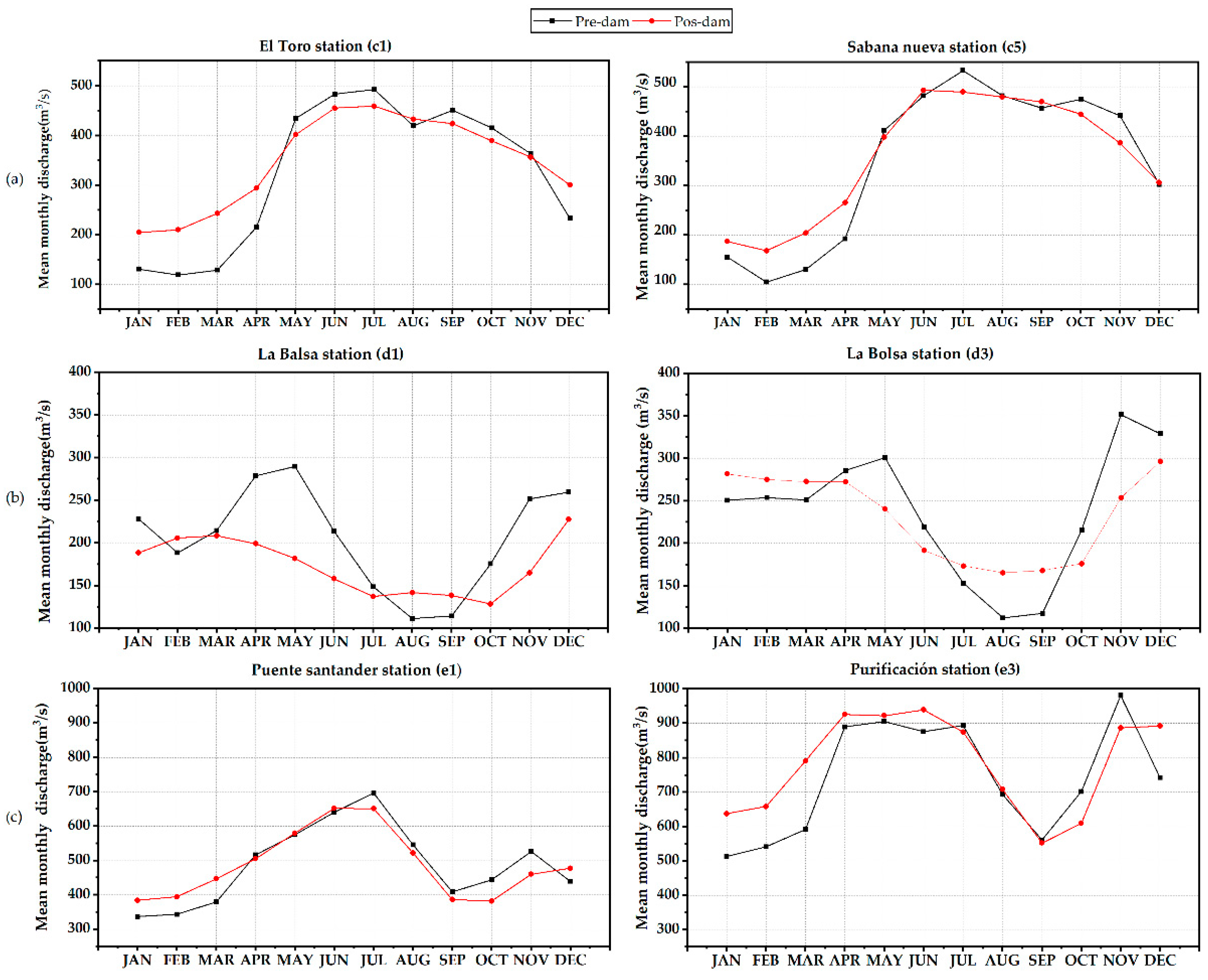

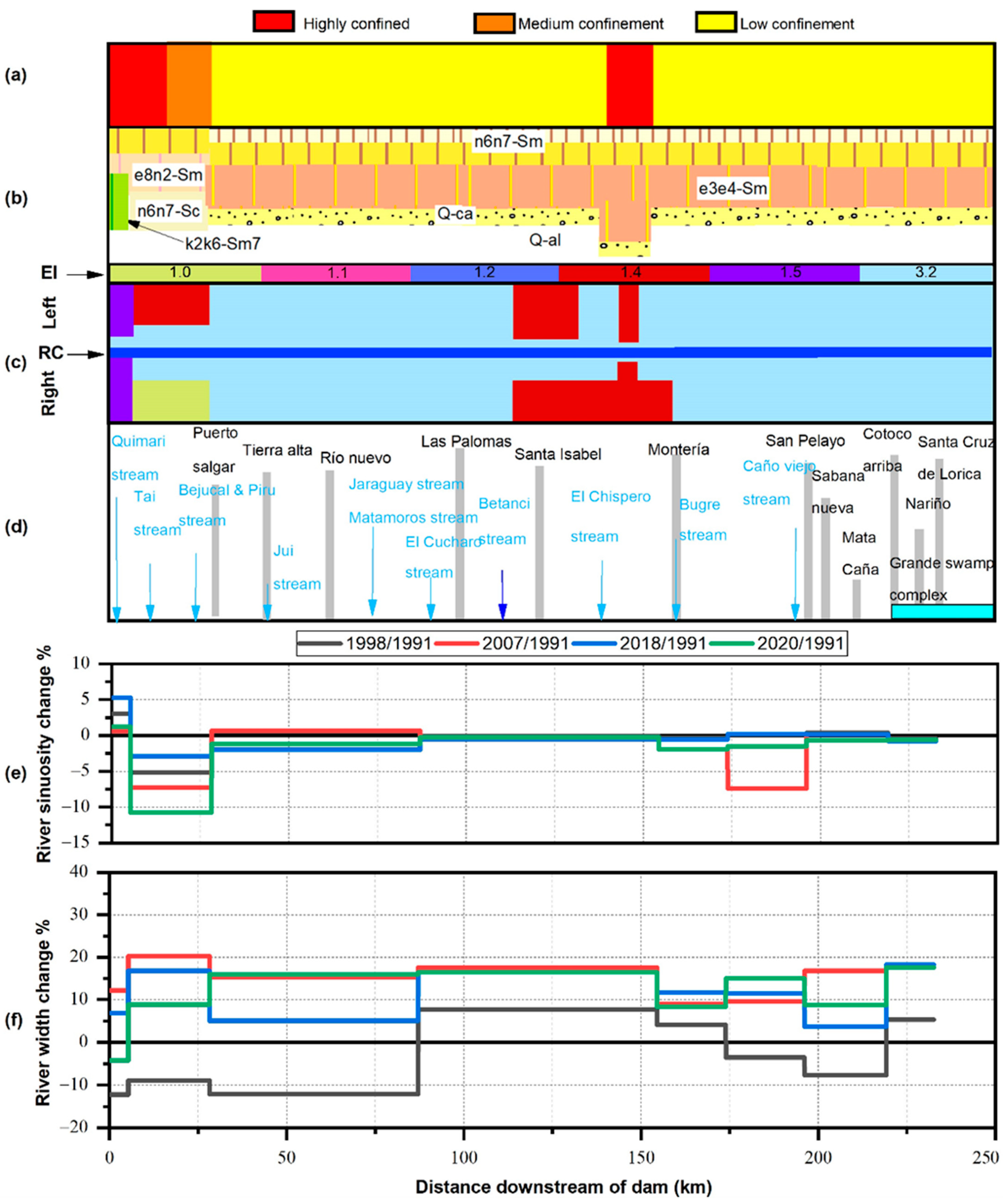
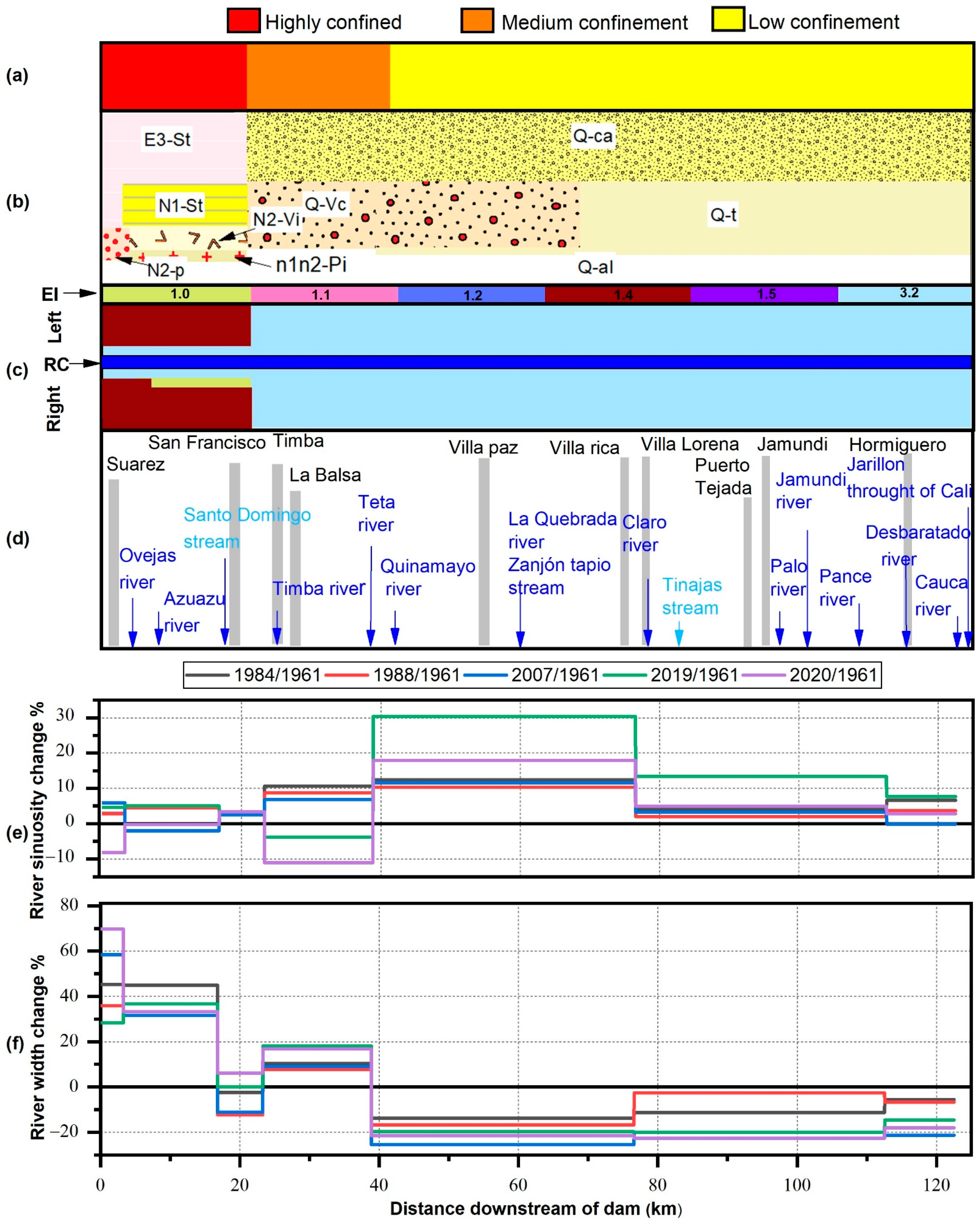
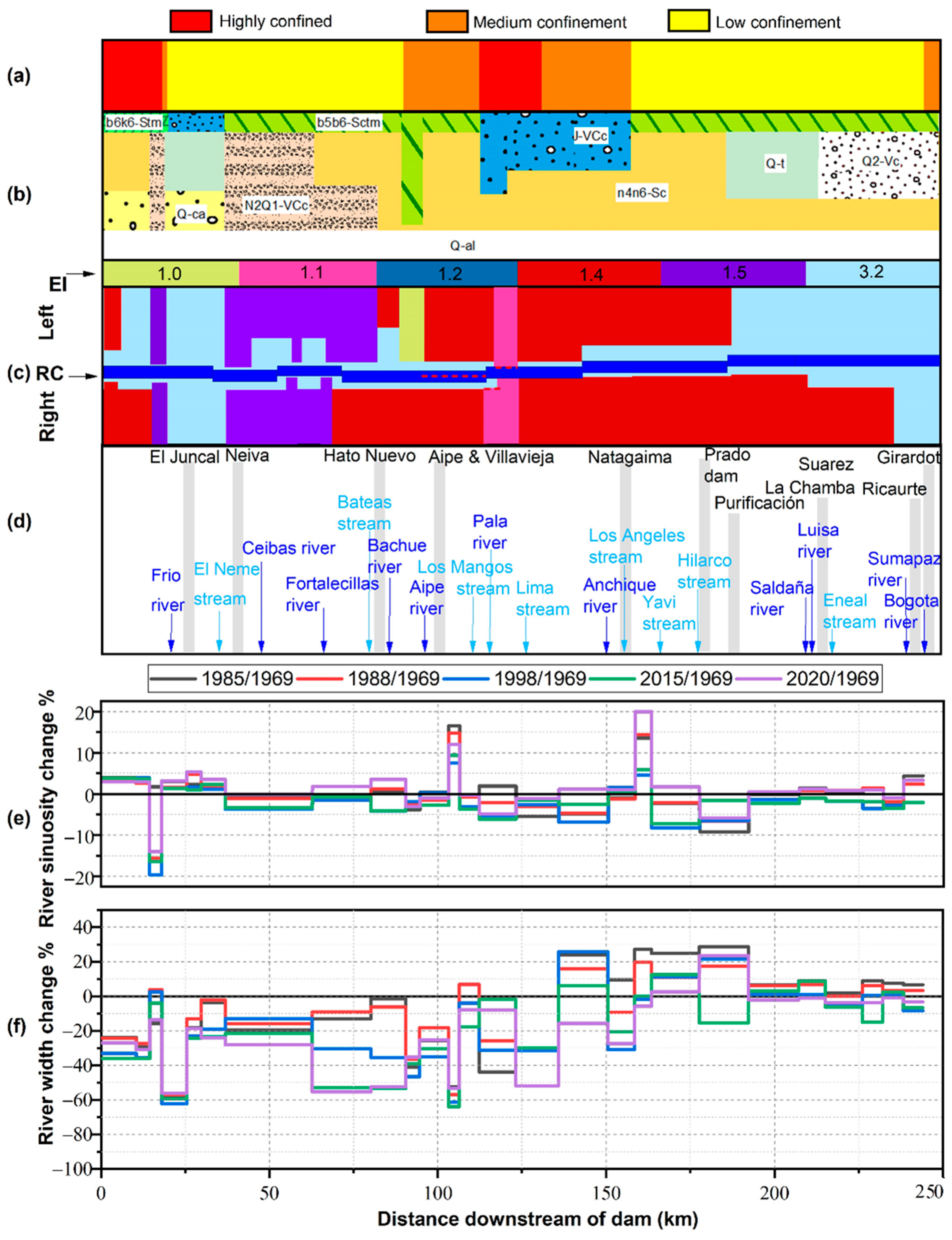


| Dam | Year Starting Operation | Height (m) | Reservoir Volume (106 m3) | Reservoir Area (m2) | Downstream Initial Channel Width (m) | Rivers Upstream of Reservoir | Rivers Downstream of Reservoir |
|---|---|---|---|---|---|---|---|
| Prado | 1972 | 75 | 1010 | 125,400 | 302 | Prado, Cunday | Magdalena |
| Salvajina | 1985 | 148 | 764 | 203,100 | 84 | Cauca | Cauca |
| Betania | 1986 | 170 | 1971 | 700,000 | 236 | Magdalena, Yaguara | Magdalena |
| Urrá I | 2000 | 100 | 1740 | 740,000 | 112 | Sinú, Verde | Sinú |
| Dam | Station | Coordinates | Elevation (masl) | Period (Years) | Downstream Distance (km) | |||
|---|---|---|---|---|---|---|---|---|
| Name | ID | Long. | Lat. | Pre-Dam | Post-Dam | |||
| Urrá I | El Toro | b1 | −76.13 | 8.11 | 100 | 1991–1998 | 2002–2010 | 26 |
| Carrizola | b2 | −76.10 | 8.16 | 55 | 1993–1998 | 2002–2020 | 40 | |
| Nueva Colombia | b3 | −75.98 | 8.50 | 20 | 1991–1998 | 2002–2020 | 112 | |
| Montería | b4 | −75.89 | 8.75 | 15 | 1963–1998 | 2002–2020 | 162 | |
| Sabana Nueva | b5 | −75.85 | 9.03 | 9 | 1979–1998 | 2002–2020 | 205 | |
| Palma Central | b6 | −75.82 | 9.20 | 6 | 1991–1998 | 2002–2010 | 230 | |
| Salvajina | La Balsa | c1 | −76.60 | 3.09 | 987 | 1976–1983 | 1987–2020 | 27 |
| Tablanca | c2 | −76.57 | 3.12 | 980 | 1978–1983 | 1987–2010 | 36 | |
| La Bolsa | c3 | −76.50 | 3.20 | 964 | 1967–1983 | 1987–2016 | 75 | |
| Prado and Betania | Puente Santander | d1 | −75.31 | 2.94 | 431 | 1960–1984 | 1988–2019 | 42 |
| Angostura | d2 | −75.12 | 3.44 | 345 | 1975–1984 | 1988–2020 | 119 | |
| Purificación | d3 | −74.94 | 3.85 | 306 | 1960–1984 | 1988–2019 | 182 | |
| Nariño | d4 | −74.84 | 4.39 | 277 | 1978–1984 | 1988–2019 | 273 | |
| Project | Closest Station to the Dam | Farthest Station to the Dam | ||||
|---|---|---|---|---|---|---|
| Station Name | Downstream Distance (km) | Reduction in Suspended Sediment (%) | Station Name | Downstream Distance (km) | Reduction in Suspended Sediment (%) | |
| Prado and Betania | Puente Santander | 42 | 70–73 | Nariño | 279 | 9 |
| Salvajina | Salvajina | 1 | 75 | Juanchito | 134 | 30 |
| Urrá I | Pasacaballos | 6 | 81 | Montería | 175 | 40 |
| Dam | Reach | Coordinates | Characteristics | ||||||
|---|---|---|---|---|---|---|---|---|---|
| Initial | Ending | L (km) | Period | W (m) | S | ||||
| Lat. | Lon. | Lat. | Lon. | ||||||
| Urrá I | Verde River | ||||||||
| 1 | 7.85 | −76.29 | 7.83 | −76.13 | 8 | Pre | 81 | 1.3 | |
| Pos | 373 | 1.1 | |||||||
| 2 | 7.83 | −76.13 | 7.80 | −76.33 | 5 | Pre | 60 | 1.0 | |
| Pos | 56 | 1.1 | |||||||
| Sinú River | |||||||||
| 1 | 7.84 | −76.29 | 7.83 | −76.25 | 6.7 | Pre | 56 | 1.2 | |
| Pos | 203 | 0.9 | |||||||
| 2 | 7.83 | −76.25 | 7.79 | −76.24 | 6.3 | Pre | 55 | 1.0 | |
| Pos | 62 | 1.0 | |||||||
| Salvajina | Cauca River | ||||||||
| 1 | 2.77 | −76.71 | 2.75 | −76.70 | 2.7 | Pre | 33 | 1.06 | |
| Pos | 92 | 1.05 | |||||||
| 2 | 2.75 | −76.70 | 2.71 | −76.74 | 5 | Pre | 44 | 1.15 | |
| Pos | 44 | 1.15 | |||||||
| Betania | Yaguará River | ||||||||
| 1 | 2.69 | −75.51 | 2.64 | −75.52 | 2.5 | Pre | 71 | 1.1 | |
| Pos | 269 | 1.1 | |||||||
| 2 | 2.64 | −75.52 | 2.63 | −75.5 | 3.5 | Pre | 55 | 1.0 | |
| Pos | 47 | 1.0 | |||||||
| Magdalena River | |||||||||
| 1 | 2.56 | −75.49 | 2.53 | −75.5 | 6.5 | Pre | 156 | 1.4 | |
| Pos | 342 | 1.1 | |||||||
| 2 | 2.53 | −75.5 | 2.47 | −75.56 | 9.5 | Pre | 122 | 1.3 | |
| Pos | 140 | 1.3 | |||||||
Disclaimer/Publisher’s Note: The statements, opinions and data contained in all publications are solely those of the individual author(s) and contributor(s) and not of MDPI and/or the editor(s). MDPI and/or the editor(s) disclaim responsibility for any injury to people or property resulting from any ideas, methods, instructions or products referred to in the content. |
© 2023 by the authors. Licensee MDPI, Basel, Switzerland. This article is an open access article distributed under the terms and conditions of the Creative Commons Attribution (CC BY) license (https://creativecommons.org/licenses/by/4.0/).
Share and Cite
Alvarado, D.C.; Vargas-Luna, A.; Giraldo-Osorio, J.D. Upstream and Downstream Changes in the Channel Width and Sinuosity Due to Dam Construction in Tropical Rivers: The Case of Colombia. Appl. Sci. 2023, 13, 7109. https://doi.org/10.3390/app13127109
Alvarado DC, Vargas-Luna A, Giraldo-Osorio JD. Upstream and Downstream Changes in the Channel Width and Sinuosity Due to Dam Construction in Tropical Rivers: The Case of Colombia. Applied Sciences. 2023; 13(12):7109. https://doi.org/10.3390/app13127109
Chicago/Turabian StyleAlvarado, Diana C., Andrés Vargas-Luna, and Juan Diego Giraldo-Osorio. 2023. "Upstream and Downstream Changes in the Channel Width and Sinuosity Due to Dam Construction in Tropical Rivers: The Case of Colombia" Applied Sciences 13, no. 12: 7109. https://doi.org/10.3390/app13127109
APA StyleAlvarado, D. C., Vargas-Luna, A., & Giraldo-Osorio, J. D. (2023). Upstream and Downstream Changes in the Channel Width and Sinuosity Due to Dam Construction in Tropical Rivers: The Case of Colombia. Applied Sciences, 13(12), 7109. https://doi.org/10.3390/app13127109












